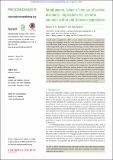Files in this item
Simultaneous failure of two sex-allocation invariants : implications for sex-ratio variation within and between populations
Item metadata
| dc.contributor.author | Rodrigues, Antonio | |
| dc.contributor.author | Gardner, Andy | |
| dc.date.accessioned | 2015-08-11T13:40:01Z | |
| dc.date.available | 2015-08-11T13:40:01Z | |
| dc.date.issued | 2015-07 | |
| dc.identifier | 188789278 | |
| dc.identifier | 8efe2861-47e0-4a05-8fce-7a5fa2d0b27b | |
| dc.identifier | 84935862598 | |
| dc.identifier | 000357719500014 | |
| dc.identifier.citation | Rodrigues , A & Gardner , A 2015 , ' Simultaneous failure of two sex-allocation invariants : implications for sex-ratio variation within and between populations ' , Proceedings of the Royal Society B: Biological Sciences , vol. 282 , no. 1810 , 20150570 . https://doi.org/10.1098/rspb.2015.0570 | en |
| dc.identifier.issn | 0962-8452 | |
| dc.identifier.uri | https://hdl.handle.net/10023/7184 | |
| dc.description | This research was supported by Wolfson College Cambridge (A.M.M.R.) and the Natural Environment Research Council (grant no. NE/K009524/1) (A.G.). | en |
| dc.description.abstract | Local mate competition (LMC) occurs when male relatives compete for mating opportunities, and may favour the evolution of female-biased sex allocation. LMC theory is among the most well-developed and empirically-supported topics in behavioural ecology, clarifies links between kin selection, group selection and game theory, and provides among the best quantitative evidence for Darwinian adaptation in the natural world. Two striking invariants arise from this body of work: the number of sons produced by each female is independent of both female fecundity and also the rate of female dispersal. Both of these invariants have stimulated a great deal of theoretical and empirical research. Here we show that both of these invariants break down when variation in female fecundity and limited female dispersal are considered in conjunction. Specifically, limited dispersal of females following mating leads to local resource competition (LRC) between female relatives for breeding opportunities, and the daughters of high-fecundity mothers experience such LRC more strongly than do those of low-fecundity mothers. Accordingly, high-fecundity mothers are favoured to invest relatively more in sons, and low-fecundity mothers are favoured to invest relatively more in daughters, and the overall sex ratio of the population sex ratio becomes more female biased as a result. | |
| dc.format.extent | 543784 | |
| dc.language.iso | eng | |
| dc.relation.ispartof | Proceedings of the Royal Society B: Biological Sciences | en |
| dc.subject | Constant male hypothesis | en |
| dc.subject | Dispersal | en |
| dc.subject | Kin selection | en |
| dc.subject | Local mate competition | en |
| dc.subject | Local resource competition | en |
| dc.subject | Viscosity | en |
| dc.subject | QH301 Biology | en |
| dc.subject.lcc | QH301 | en |
| dc.title | Simultaneous failure of two sex-allocation invariants : implications for sex-ratio variation within and between populations | en |
| dc.type | Journal article | en |
| dc.contributor.sponsor | NERC | en |
| dc.contributor.institution | University of St Andrews.School of Biology | en |
| dc.contributor.institution | University of St Andrews.Centre for Biological Diversity | en |
| dc.identifier.doi | 10.1098/rspb.2015.0570 | |
| dc.description.status | Peer reviewed | en |
| dc.identifier.grantnumber | NE/K009524/1 | en |
This item appears in the following Collection(s)
Items in the St Andrews Research Repository are protected by copyright, with all rights reserved, unless otherwise indicated.

